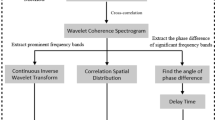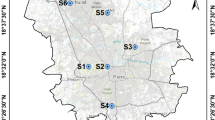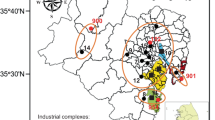Abstract
The present study aims to investigate the role/contribution of residential combustion (using levoglucosan as a tracer of biomass combustion) during PM10 episode days registered over the Porto urban area (Portugal), in order to support air quality plans that need to be developed for this particular region. The levoglucosan and PM10 concentration values, together with the meteorological conditions (namely temperature), measured during an experimental field campaign performed in 2013, were used in this study. To this end, a wavelet-based approach is applied to (a) better quantify the coherence and dependency of these variables and (b) assess the strength of the connection between the two pollutants species (PM and levoglucosan) at different time scales. Results evidenced a high coherence/dependency between PM10 and levoglucosan values for the episodes selected (periods with exceedances of the PM10 limit values), suggesting the contribution of biomass combustion sources. The highest coherence (normalised covariance) is observed for the winter episodes and time periods of 5–10 days, which is related to the duration of the episodes selected. The summertime episode, which exhibits a negligible observed correlation between temperature and levoglucosan, is explained by the influence of forest fires that occurred within this period and region.







Similar content being viewed by others
References
Amato F, Alastuey A, Karanasiou A, Lucarelli F, Nava S, Calzolai G, Severi M, Becagli S, Gianelle VL, Colombi C, Alves C, Custodio D, Nunes T, Cerqueira M, Pio C, Eleftheriadis K, Diapouli E, Reche C, Minguillon MC, Manousakas MI, Maggos T, Vratolis S, Harrison RM, Querol X (2016) AIRUSE-LIFE plus: a harmonized PM speciation and source apportionment in five southern European cities. Atmos Chem Phys 16(5):3289–3309
Bølling AK, Pagels J, Yttri KE, Barregard L, Sallsten G, Schwarze PE, Boman C (2009) Health effects of residential wood smoke particles: the importance of combustion conditions and physicochemical particle properties. Part Fibre Toxicol 6:29. https://doi.org/10.1186/1743-8977-6-29
Borrego C, Sá E, Monteiro A, Ferreira J, Miranda AI (2009) Forecasting human exposure to atmospheric pollutants—a modelling approach. Atmos Environ 43:5796–5806. https://doi.org/10.1016/j.atmosenv.2009.07.049
Borrego C, Valente J, Carvalho A, Sá E, Lopes M, Miranda AI (2010) Contribution of residential wood combustion to PM10 levels in Portugal. Atmos Environ 44:642–651. https://doi.org/10.1016/j.atmosenv.2009.11.020
Brown SG, Lee T, Roberts PT, Collett JL Jr (2016) Wintertime residential biomass burning in Las Vegas, Nevada; marker components and apportionment methods. Atmosphere-Basel 7:58. https://doi.org/10.3390/atmos7040058
Calvo AI, Martins V, Nunes T, Duarte M, Hillamo R, Teinilae K, Pont V, Castro A, Fraile R, Tarelho L, Alves C (2015) Residential wood combustion in two domestic devices: relationship of different parameters throughout the combustion cycle. Atmos Environ 116:72–82
Caseiro A, Bauer H, Schmidl C, Pio CA, Puxbaum H (2009) Wood burning impact on PM10 in three Austrian regions. Atmos Environ 43:2186–2195
Duque L, Relvas H, Silveira C, Ferreira J, Monteiro A, Gama C, Rafael S, Freitas S, Borrego C, Miranda AI (2016) Evaluating strategies to reduce urban air pollution. Atmos Environ 127:196–204. https://doi.org/10.1016/j.atmosenv.2015.12.043
Gelencsér A, May B, Simpson D, Sánchez-Ochoa A, Kasper-Giebl A, Puxbaum H, Caseiro A, Pio C, Legrand M (2007) Source apportionment of PM2.5 organic aerosol over Europe: primary/secondary, natural/anthropogenic, and fossil/biogenic origin. J Geophys Res 112(D23S04):1–12
Giannoni M, Martellini T, Del Bubba M, Gambaro A, Zangrando R, Chiari M, Lepri L, Cincinelli A (2012) The use of levoglucosan for tracing biomass burning in PM2.5 samples in Tuscany (Italy). Environ Pollut 167:7–15
Gonçalves C, Alves C, Pio C (2012) Inventory of fine particulate organic compound emissions from residential combustion in Portugal. Atmos Environ 50:297–306
Grinsted A, Moore JC, Jevrejeva S (2004) Application of the cross wavelet transform and wavelet coherence to geophysical time series. Nonlin Process Geophys 11:561–566. https://doi.org/10.5194/npg-11-561-2004
Hedberg E, Kristensson A, Ohlsson M, Johansson C, Johansson PÅ, Swietlicki E, Vesely V, Wideqvist U, Westerholm R (2002) Chemical and physical characterization of emissions from birch wood combustion in a wood stove. Atmos Environ 36:4823–4837. https://doi.org/10.1016/S1352-2310(02)00417-X
Hennigan CJ, Sullivan AP, Collett JL, Robinson AL (2010) Levoglucosan stability in biomass burning particles exposed to hydroxyl radicals. Geophys Res Lett 37:L09806
Hoffmann D, Tilgner A, Iinuma Y, Herrmann H (2010) Atmospheric stability of levoglucosan: a detailed laboratory and modeling study. Environ Sci Technol 44:694–699
ICNF (2014) Relatório provisório de incêndios florestais (2014) Instituto de Conservação da Natureza e das Florestas. Departamento de Gestão de Áreas Classificadas, Públicas e de Proteção Florestal. Available at: http://www.icnf.pt/portal/florestas/dfci/Resource/doc/rel/2014/DFCI-rp7-20140915.pdf. Accessed 10 October 2017
JRC- Joint Research Center, Institute for Environment and Sustainability (2014) Forest fires in Europe, Middle East and North Africa 2013. JRC Technical Reports. https://doi.org/10.2788/99870 (online). Available at: http://forest.jrc.ec.europa.eu/media/cms_page_media/9/FireReport2013_final2pdf_2.pd. Accessed 10 October 2017
Krecl P, Larsson EH, Ström J, Johansson C (2008) Contribution of residential wood combustion and other sources to hourly winter aerosol in Northern Sweden determined by positive matrix factorization. Atmos Chem Phys 8:3639–3653
Lanz VA, Alfarra MR, Baltensperger U, Buchmann B, Hueglin C, Prévôt ASH (2007) Source apportionment of submicron organic aerosols at an urban site by factor analytical modelling of aerosol mass spectra. Atmos Chem Phys 7:1503–1522
Miranda A, Silveira C, Ferreira J, Monteiro A, Lopes D, Relvas H, Borrego C, Roebeling P, Turrini E, Volta M (2015) Current air quality plans in Europe designed to support air quality management policies. Atmos Pol Res 6:434–443. https://doi.org/10.5094/APR.2015.048
Mochida M, Kawamura K, Fu P, Takemura T (2010) Seasonal variation of levoglucosan in aerosols over the western North Pacific and its assessment as a biomass-burning tracer. Atmos Environ 44:3511–3518
Monteiro A, Miranda AI, Borrego C, Vautard R (2007) Air quality assessment for Portugal. Sci Total Environ 373:22–31. https://doi.org/10.1016/j.scitotenv.2006.10.014
Monteiro A, Lopes J, Gouveia S, Scotto M, Feliciano M, Miranda AI (2016) Investigating ozone episodes in Portugal: a wavelet-based approach. Air Qual Atmos Health 9(7):775–783. https://doi.org/10.1007/s11869-015-0379-7
Nolte CG, Schauer JJ, Cass GR, Simoneit BRT (2001) Highly polar organic compounds present in wood smoke and in the ambient atmosphere. Environ Sci Technol 35:1912–1919
Percival and Walden 2006, Percival DB, Walden AT (2006) Wavelet methods for time series analysis. Cambridge University Press, Cambridge
Perrone MG, Larsen BR, Ferrero L, Sangiorgi G, De Gennaro G, Udisti R, Zangrando R, Gambaro A, Bolzacchini E (2012) Sources of high PM2.5 concentrations in Milan, Northern Italy: molecular marker data and CMB modelling. Sci Total Environ 414:343–355
Piazzalunga A, Fermo P, Bernardoni V, Vecchi R, Valli G, De Gregorio MA (2010) A simplified method for levoglucosan quantification in wintertime atmospheric particulate matter by high performance anionexchange chromatography coupled with pulsed amperometric detection. Int J Environ An Ch 90:934–947
Puxbaum H, Caseiro A, Sánchez-Ochoa A, Kasper-Giebl A, Claeys M, Gelencsér A, Legrand M, Preunkert S, Pio C (2007) Levoglucosan levels at background sites in Europe for assessing the impact of biomass combustion on the European aerosol background. J Geophys Res Research 112:D23S05
Reche C, Viana M, Amato F, Alastuey A, Moreno T, Hillamo R, Teinila K, Saarnio K, Seco R, Penuelas J, Mohr C, Prevot ASH, Querol X (2012) Biomass burning contributions to urban aerosols in a coastal Mediterranean city. Sci Total Environ 427-428:175–190
Torrence C, Compo GP (1998) A practical guide to wavelet analysis. Bull Am Meteorol Soc 79:61–78. https://doi.org/10.1175/1520-0477
Vicente E, Duarte M, Calvo AI, Nunes T, Tarelho L, Custódio D, Colombi C, Gianelle C, Sanchez de la Campa A, Alves C (2015) Influence of operating conditions on chemical composition of particulate matter emissions from residential combustion. Atmos Res 166:92–100
Vu B, Alves CA, Gonçalves C, Pio C, Gonçalves F, Pereira R (2012) Mutagenicity assessment of aerosols in emissions from wood combustion in Portugal. Environ Pollut 166:172–181
Zdráhal Z, Oliveira J, Vermeylen R, Claeys M, Maenhaut W (2002) Improved method for quantifying levoglucosan and related monosaccharide anhydrides in atmospheric aerosols and application to samples from urban and tropical locations. Environ Sci Technol 36:747–753
Zeri M, Oliveira JF, Lyra GB (2011) Spatiotemporal analysis of particulate matter, sulfur dioxide and carbon monoxide concentrations over the city of Rio de Janeiro, Brazil. Meteor Atmos Phys 113:139–152
Zeri M, Carvalho VSB, Cunha-Zeri G, Oliveira-Júnior JF, Lyra GB, Freitas ED (2016) Assessment of the variability of pollutants concentration over the metropolitan area of São Paulo, Brazil, using the wavelet transform. Atmos Sci Lett 17:87–95
Zhang X, Hecobian A, Zheng M, Frank NH, Weber RJ (2010) Biomass burning impact on PM2.5 over the southeastern US during 2007: integrating chemically speciated FRM filter measurements, MODIS fire counts and PMF analysis. Atmos Chem Phys 10:6839–6853
Acknowledgements
The authors wish to thank the financial support from AIRUSE LIFE+ (ENV/ES/584) EU project. This work was partially supported by the Portuguese Foundation for Science and Technology (FCT), with national (MEC) and European structural funds through the programmes FEDER, under the partnership agreement PT2020—within IEETA/UA project UID/CEC/00127/2013 (Instituto de Engenharia Electrónica e Informática de Aveiro, IEETA/UA, Aveiro), CIDMA/UA project UID/MAT/04106/2013 (Centro de Investigação e Desenvolvimento em Matemática e Aplicações, CIDMA/UA, Aveiro) and CESAM (UID/AMB/50017-POCI-01-0145-FEDER-007638) within the PT2020 Partnership Agreement and Compete 2020. S. Gouveia and C. Gama acknowledge the postdoctoral and doctoral grants by FCT (SFRH/BPD/87037/2012 and SFRH/BD/87468/2012, respectively).
Author information
Authors and Affiliations
Corresponding author
Rights and permissions
About this article
Cite this article
Monteiro, A., Gouveia, S., Scotto, M. et al. Investigating PM10 episodes using levoglucosan as tracer. Air Qual Atmos Health 11, 61–68 (2018). https://doi.org/10.1007/s11869-017-0521-9
Received:
Accepted:
Published:
Issue Date:
DOI: https://doi.org/10.1007/s11869-017-0521-9




